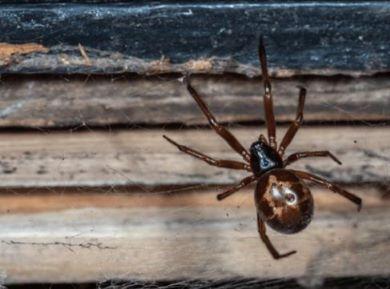False Widow Spider advice
About False Widow Spiders
There are six types of false widow spider in the UK of the genus Steatoda. All except Steatoda nobilis are native to the UK. They are called false widow spiders due to their similarity in appearance to black widow spiders.

Steatoda nobilis (or Noble False Widow Spider) was accidentally introduced into the UK over 100 years ago from the Canary and Madeira islands. They became established near the south coast, increasing in number and expanding further north over the last 25 years, believed to be as a result of warmer winters.
The Noble False Widow Spider has a bulbous abdomen which is brownish in colour and usually has distinctive cream markings which to some looks like a skull. They have spindly reddish-orangey legs. Only the females are capable of piercing people’s skin and can grow up to 32mm including legs.
Finding False Widow Spiders
In the UK they usually inhabit south facing walls, conservatories and toilet blocks, creating scaffold like tangle webs.
Information on being bitten
Bites from a Noble False Widow Spider are rare and usually as a result of the spider being roughly handled or becoming trapped between clothes and skin.
Despite probably being the UK’s most venomous spider, the bite from a Noble False Widow Spider is usually no worse than a bee or wasp sting, although a few people may experience a throbbing pain, swelling and tingling in their fingers.
More severe symptoms, such as reported by the media, are likely a result of an allergic reaction or subsequent infection of the wound and not all have been confirmed as bites from a noble false widow. There have been no fatalities from any spider bite in the UK, including the Noble False Widow Spider.
If you are bitten by a spider or stung/bitten by an insect then you must ensure that the wound does not get infected, by cleaning it with an antiseptic wash or soap and water as soon as possible. Placing a flannel or cloth soaked in cold water over the wound will help reduce any swelling. Avoid scratching the affected area to reduce the risk of infection. If there is a lot of swelling/blistering or there is pus in the wound this may indicate the wound has become infected. In that event you are advised to consult your local doctor.
If you experience any of the following symptoms as a result of a bite/sting then you are advised to call 999 and ask for an ambulance;
- wheezing or difficulty breathing
- nausea, vomiting or diarrhoea
- A fast heart rate
- dizziness or feeling faint
- difficulty swallowing
- confusion, anxiety or agitation
For further details visit the NHS website.
How do I treat spiders?
Should you see a spider within your property, which you believe may be a Noble False Widow, and you wish to remove it you are advised as a precaution not to handle the spider with your bare hands as the spider may bite in self-defence.

